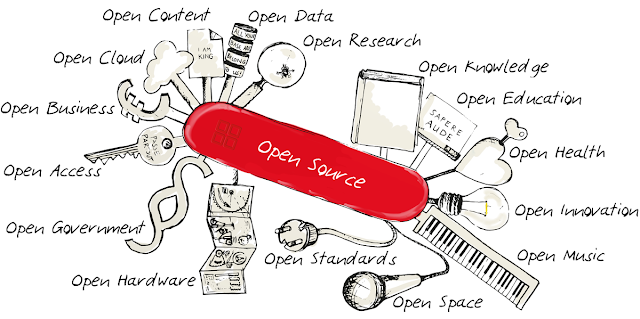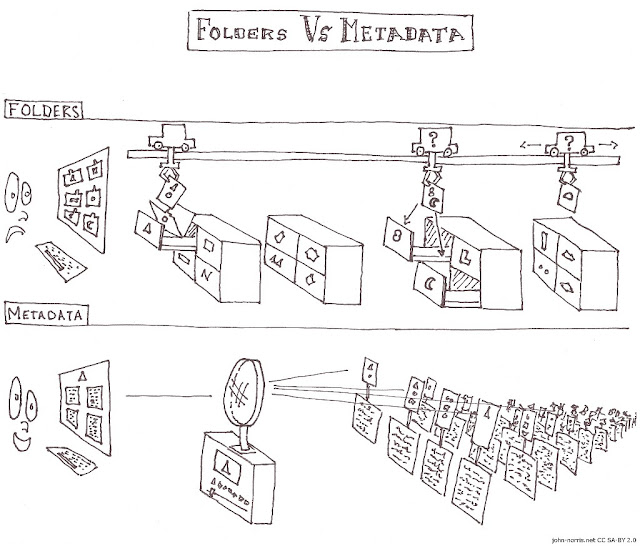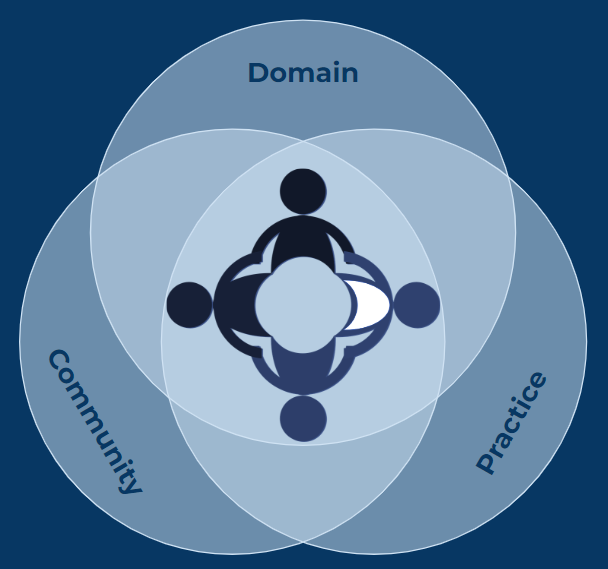Open Source
Something that is offered as "open source" is made freely available for potential modification and redistribution by anybody, and is done so, in part, to encourage collaborative development. The term most often refers to software (with the word 'source' referring to the underlying code used to write it) but is also applied to other types of digital resource including raw data, media and educational materials.
The image below represents some of the many aspects of open source technologies available. The word "source" refers to the source code (the basic building blocks of software). The word "open" is used in the sense of being not legally "closed" in terms of access, modification or distribution. Open source software is usually available free of charge for general use, though some developers may charge for the use of their versions of the software where, for example, they have added particular features that others want. Popular examples of open source software include Libre Office and Audacity.

|
| Open Swiss Knife, by Johannes Spielhagen, Bamberg, Germany, CC BY-SA 3.0, via Wikimedia Commons |
The word "freely" in the first line of this post might seem to have an obvious definition, but it's worth investigating further what exactly is meant by it. The open source movement is guided by certain philosophies, one of which explains what is meant by "freedom", and is often referred to as "the 4 Freedoms". These are, in short:
- Inspect: you are free to study software (or other type of resource) in order to understand how it works (which necessarily requires that you can access its 'source').
- Use: You are free to (for example) run the software, or present a resource to your students. It may be that somebody's adaptation of the software attracts a fee, but upon purchasing it, it may be released to others for free.
- Modify: Once you've understood the resource well enough to know how to do so, you're free to change it, either to improve, fix or update part of it, or make it do something different.
- Sell: When you've updated something you can charge others to make use of it if you wish, but the source is still available to those people and others may well distribute their own versions of, whether for free or for a price.
A significant benefit of the open source ideal is that it allows organisations with limited funds (such as schools and museums, and also individuals) to access and use a wide range of digital resources without needing to pay for expensive licences. This could allow them to save money over the long-term, or just to experiment with new tools and technologies without making large or long-term financial commitments.
There are many open source alternatives to popular commercial tools. For example:
- LibreOffice is an open source office suite that may be considered as an alternative to the Microsoft Office or Office 365.
- Linux is a broad family of open source operating systems that may be considered as an alternative to Windows or Mac OS.
- Moodle is an open source Learning Management System that could take the place of a commercial LMS.
- Less reliable or consistent technical support: part of what you're paying for when paying for Windows (for example) is having an official place to find help when something goes wrong, and a central organisation that is commercially motivated to provide it. For an open source solution that attracts a lot of talented and motivated developers it can sometimes be the case that updates, bug fixes and security enhancements actually happen faster, however, due to the collaborative nature of open source development.
- More work in the background: A commercial LMS will usually include initial setup, with users needing only to add detail and upload materials to an existing infrastructure. Moodle, for example, needs designing from the ground up and maintained, which requires either in-house time and expertise or paying for an external expert to do it.
- An appropriate infrastructure: commercial web-based software needs to be hosted on appropriate servers which requires not only server space in the first place, but also someone (or a team of people) capable of installing and then maintaining it. With commercial software this usually happens behind the scenes, but using open source software puts this responsibility on the shoulders of the user.
- Restricted features: often due to the limitations outlined above, open source software may not have the same features as the commercial alternatives. For example, LibreOffice can be installed on most computers and provide an excellent cost-free alternative to Microsoft Office, but the collaborative working features of MS Word, for example, are not as easily replicated in LibreOffice Writer because these require a lot of processing and data storage that takes place on web-based servers: not only do they require the correct physical structure to be in place, but also the expertise to install, set up and maintain the software that governs the necessary processes.
- An overarching consideration with all of these is security and reliability: whilst commercial organisations have a vested interest in helping individuals and organisations to keep their documents and data secure, open source developers have no control over the environment within which you choose to use the tools they create.
Given an individual or organisation's available resources, open source software may have significant benefits over the popular commercial options, but it may also be the case that open source is more effort than it is worth: There's no short answer to the question "is it better to use open source or commercial software?"
In some cases, developers monetise the software they develop not by way of charging for the use of the software itself, but by offering services that enable people to utilise it. For example, the Moodle LMS is free for anyone to use if they are able to install it on their own server, but some individuals and organisations offer chargeable services relating to setting up and maintaining a Moodle instance, or providing space on a server for its installation.
As well as software, educational resources may be offered under an open source licence. These are often referred to as Open Educational Resources (OER) and may include textbooks, lesson plans, downloadable resources such as worksheets, and multimedia content, often with Creative Commons licences applied. For cultural organisations such as museums, offering quality, targeted open educational resources under Creative Commons licences can be a great way of spreading understanding of their work, stories and history through society via educators and students.
Open source educational resources are particularly useful for educators who want to customise their teaching materials to meet the specific needs of their students, or to take advantage of opportunities offered by new and emerging technologies. Their use can also have tangential benefits for the students themselves with opportunities to collaborate on projects enabling them to practise important skills like teamwork and problem solving in the process. Additional benefits for students may be found in the exposure to a wider range of technologies, potentially encouraging them to experiment and innovate.
Whilst open source software and other materials can provide powerful tools for everyone including educators and learners, they do tend to require a slightly higher level of basic digital skills and knowledge than commercial and proprietary alternatives. Those who are new to open source may want to get started by exploring some of the resources (including communities) that are available online. It can seem daunting at first, but with a little bit of practice and experimentation there are benefits to be found even in the simplest interactions with what open source has to offer.
Next steps:
- Browse educational materials listed at OER Commons. Try searching for materials related to your work or interests.
- Have you/ your organisation produced anything that might be suitable as an OER? Why not sign up for an OER Commons account and submit it. You might want to make sure it has an appropriate Creative Commons licence applied first.
Further reading
- In the Glossary: Creative Commons |
- Elsewhere online: OER Commons | Open Education Resources (UNESCO) | Open Source (Wikipedia)








.png)

Comments
Post a Comment